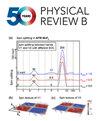基于量子点的安德烈耶夫分子的电流-相位关系的强非局部调整
IF 3.7
2区 物理与天体物理
Q1 Physics and Astronomy
引用次数: 0
摘要
最近实现的最小基塔耶夫链为马约拉纳研究带来了突破,使通过超导体间隔耦合的量子点阵列成为拓扑量子架构最有前途的合成量子材料。在本文中,我们研究了这一平台的基本构件--通过超导体耦合的两个量子点(被称为安德烈耶夫分子)--在一种配置中,创建了两个超导(SC)环,以调整跨量子点的 SC 相位差。这使我们能够考虑库仑相互作用,而这在以前研究的系统中是不可能实现的。我们证明,安德烈耶夫分子具有很强的非局部约瑟夫森效应:随着一个结点的调整,另一个结点的电流相位关系(CPR)也会发生改变。这种结构承载着 0-π 转变,并显示出可调的反常 φ0 相移,在两种情况下都是非局部控制的,而不依赖于以往研究中使用的自旋轨道相互作用或泽曼场。此外,还可以观察到明显的 SC 二极管效应和 π 周期 CPR。所提出的非局部 CPR 可作为安德烈耶夫分子态形成的标志,并在总体上介绍了调整量子结构的方法。本文章由计算机程序翻译,如有差异,请以英文原文为准。

Strong nonlocal tuning of the current-phase relation of a quantum dot based Andreev molecule
Recent realization of minimal Kitaev chains brought a breakthrough in Majorana research, which made arrays of quantum dots coupled by superconductor spacers the most promising synthetic quantum material for topological quantum architectures. In this paper, we investigate the basic building block of this platform—two dots coupled via a superconductor (referred to as an Andreev molecule)—in a configuration where two superconducting (SC) loops are created to tune the SC phase difference across the dots. This enables us to consider Coulomb interactions which was not possible in previously studied systems. We demonstrate that the Andreev molecule shows a strong nonlocal Josephson effect: As the dot in one junction is tuned, the current-phase relation (CPR) of the other dot is modified. This architecture hosts transitions and shows a tunable anomalous phase shift, nonlocally controlled in both cases, without relying on spin-orbit interaction or Zeeman fields used in previous studies. In addition, a significant SC diode effect and -periodic CPRs can be observed. The presented nonlocal CPR can be used as a signature of the formation of an Andreev molecular state and in general to introduce ways to tune quantum architectures.
求助全文
通过发布文献求助,成功后即可免费获取论文全文。
去求助
来源期刊

Physical Review B
物理-物理:凝聚态物理
CiteScore
6.70
自引率
32.40%
发文量
0
审稿时长
3.0 months
期刊介绍:
Physical Review B (PRB) is the world’s largest dedicated physics journal, publishing approximately 100 new, high-quality papers each week. The most highly cited journal in condensed matter physics, PRB provides outstanding depth and breadth of coverage, combined with unrivaled context and background for ongoing research by scientists worldwide.
PRB covers the full range of condensed matter, materials physics, and related subfields, including:
-Structure and phase transitions
-Ferroelectrics and multiferroics
-Disordered systems and alloys
-Magnetism
-Superconductivity
-Electronic structure, photonics, and metamaterials
-Semiconductors and mesoscopic systems
-Surfaces, nanoscience, and two-dimensional materials
-Topological states of matter
 求助内容:
求助内容: 应助结果提醒方式:
应助结果提醒方式:


